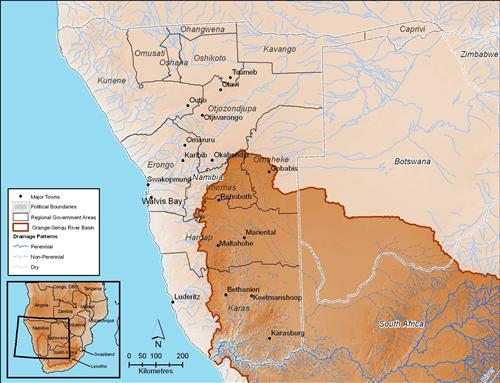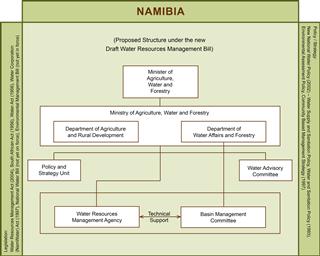Namibia gained independence from South Africa in 1990; its policy and legislation naturally reflects their origin, though since independence it has adopted a number of important water reforms.
Namibia’s legislative framework for water management is established by the Water Act No. 54 of 1956. The purpose of the Water Act is to control the use and conservation of water for domestic, agricultural, urban and industrial purposes. Namibia has enacted several important water reforms since independence in 1990 including the Water Supply and Sanitation Sector Policy of 1993 and the National Water Policy White Paperin August 2000, which formed the basis for new Water Act (Kranz et al. 2005).
The Water Resources Management Act 2004, classifies water resources as national assets, and provides a modern legal framework for managing water resources based on the principles of integrated water resources management. The Act states that Namibia shall start to “promote the equitable and beneficial use of international watercourses, based on general accepted principles and practices of international law”. This act replaces the 1956 Water Act. Namibia was begun implementing a number of requirements of the new Act, such as, the establishment of Basin Management Committees.
Namibia’s institutions and laws are in transition to a new and comprehensive Water Act (ORASECOM 2007a). The Water Resources Management Bill has been approved by the Cabinet in 2010. The Bill was promulgated recognizing the technicalities of implementing the Water Resources Management Act 2004. The bill recognizes water resources as scarce and unevently distributed, and must be harmoniously shared between people and the environment. It promotes integrated and sustainable management of water, and delegates task to the regional/basin level to involve people at local level (particularly women) in watershed management and planning.

Namibia in relation to the Orange-Senqu River basin.
Source:Hatfield 2009
( click to enlarge )
Other relevant laws include:
-
The Namibia Water Corporation Act (Act 12 of 1997), which stipulates that the Corporation is to supply water to customers
-
The Mountain Catchment Areas Act, 63 of 1970
Institutional Responsibilities
Under the existing institutional arrangements, the Ministry of Agriculture, Water and Rural Developmetn (MAWRD) is responsible for overall management of water resources in Namibia. MAWRD is composed of the Department of Agriculture and Rural Development (DARD) and the Department of Water Affairs (DWA). The DWA is further divided to Directorate of Resource Management (DRM) and the Directorate of Rural Water Supply (DRWS). The DRM has the responsibility for ensuring protection and sustainable use of water resources, as well as for overall planning and regulation of the water sector, including water abstraction and allocation. The DRWS is responsible for supplying water to rural areas in Namibia (ORASECOM 2007a).
Several new institutions are to be established under the new Water Resources Management Bill. They include a Water Advisory Council, Basin Management Committees, Water Regulatory Board and a Water Tribunal (ORASECOM 2007a).
The new institutional structures proposed under the Water Resources Management Act are presented in the diagram below.
 Proposed institutional structures for Namibia. Source:Kranz et al. 2005; DWAF South Africa 2004 ( click to enlarge ) |
Regulatory Framework for Transboundary Water Management
Namibia is a signatory to a number of international agreements, such as, the Helsinki Rules on Shared Watercourses, the UN Convention, and the SADC Protocols on Shared Watercourses. The ongoing transformation of the institutional structures for water governance in Namibia represents an opportunity to facilitate the IWRM Plan for the Orange-Senqu River basin for improved management of shared watercourses.
Regulatory Framework for Disaster Management
Namibia faces a significant risk from hydrological and climate change-related hazards. Almost the entire country is susceptible to droughts. Between 1999 and 2003, Namibia faced six severe droughts and floods, affecting over a million people (Dahlberg and Wingqvist 2008). The Directorate Disaster Risk Management (DDRM) within the Office of the Prime Minister is responsible for coordinating all disaster risk reduction initiatives in Namibia. DDRM, in support of the National Disaster Risk Management System has conducted a number of activities (GRN, 2011):
-
Established structures at national, regional and constituency levels to address disasters and emergencies
-
Developed a National Disaster Plan
-
Developed a National Action Plan for Disaster Risk Reduction
-
Developed the National Disaster Risk Management Policy
-
Conducted national training programmes in disaster preparedness
-
Contributed to the SADC Disaster Management Strategy
-
Established a National Vulnerability Assessment Committee for Namibia (NVAC)
Challenges
The new Water Resources Management Bill and it's proposed institutional strcuture represents a significant and ambitious move towards an integrated management framework in Nambia. This requires significant restructuring of existing institutional structures and policies and legislations that formed them. It is also established based on the South African institutional structure. Considering the extent of problems that South Africa has encountered (with generally better financial and technical capacity), there are concerns about Namibia's capacity to effectively implement provisions under the new Bill (ORASECOM 2007a).
Documents related to the national water laws in Namibia can be viewed in the Document Library.
